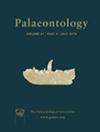Illuminating the evolution of bioluminescence in sharks
IF 2.3
2区 地球科学
Q1 PALEONTOLOGY
引用次数: 0
Abstract
The evolutionary context in which shark bioluminescence originated is poorly understood, despite it being critical to uncovering influential factors in the evolutionary history and diversity of living chondrichthyans as well as the mechanisms of deep‐water colonization by vertebrates. This study provides the first joint reconstruction of the habitats, lifestyles, and occurrence of bioluminescence in the evolution of squalomorph sharks using ancestral state estimation analysis to resolve the timing of deep‐sea colonization, the evolutionary origin of bioluminescence and the ancestral ecologies of this group. The results suggest that most squalomorphs originated in neritic environments from where they colonized deep waters on several independent occasions during the Late Jurassic and Early Cretaceous, predating most of the previous estimates of the timing of this event. The colonization of the deep sea took place via the benthic zone, in contrast to the view that an intermediate mesopelagic stage occurred during this ecological transition. Finally, the analyses accounting for uncertainty of the presence of bioluminescence strongly support that this trait evolved only once among sharks in a bathydemersal ancestor. This study reveals that shark bioluminescence evolved in a complex scenario that combines elements of several previous proposals, and enriches our perspective on the sequence of events that characterized the vertebrate conquest of the deep sea.阐明鲨鱼生物发光的进化
鲨鱼生物发光起源的进化背景尚不清楚,尽管它对于揭示生活软骨鱼纲动物进化史和多样性的影响因素以及脊椎动物在深水中定殖的机制至关重要。这项研究首次联合重建了角鲨形态鲨鱼进化过程中的栖息地、生活方式和生物发光的发生,使用祖先状态估计分析来解决深海定殖的时间、生物发光的进化起源和该群体的祖先生态。研究结果表明,大多数角鲨形态起源于浅海环境,在侏罗纪晚期和白垩纪早期,它们曾多次独立地在浅海环境中定居,早于之前对这一事件发生时间的大多数估计。深海的殖民化是通过海底区进行的,这与在这一生态过渡期间出现中期中上层阶段的观点形成了鲜明对比。最后,对生物发光存在的不确定性进行的分析有力地支持了这种特征在深海海底祖先的鲨鱼中只进化过一次。这项研究表明,鲨鱼的生物发光是在一个复杂的场景中进化而来的,它结合了之前几项提议的元素,丰富了我们对脊椎动物征服深海的事件序列的看法。
本文章由计算机程序翻译,如有差异,请以英文原文为准。
求助全文
约1分钟内获得全文
求助全文
来源期刊

Palaeontology
地学-古生物学
CiteScore
5.60
自引率
3.80%
发文量
43
审稿时长
6 months
期刊介绍:
Palaeontology publishes a wide variety of papers on palaeontological topics covering:
palaeozoology
palaeobotany
systematic studies
palaeoecology
micropalaeontology
palaeobiogeography
functional morphology
stratigraphy
taxonomy
taphonomy
palaeoenvironmental reconstruction
palaeoclimate analysis and biomineralization studies.
 求助内容:
求助内容: 应助结果提醒方式:
应助结果提醒方式:


